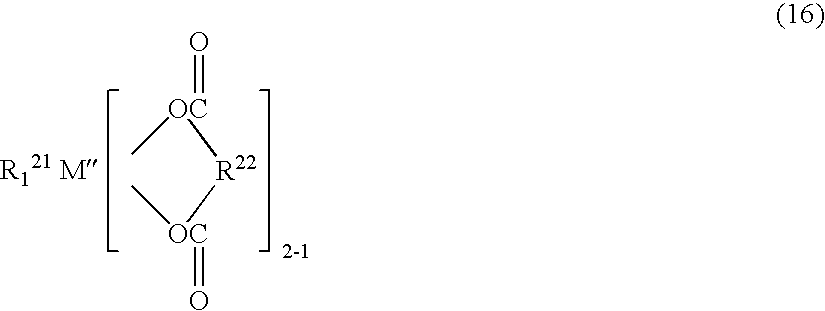Method of producing conjugated diene polymers with narrow molecular weight distribution and polymer produced
a technology of molecular weight distribution and conjugated diene, which is applied in the field of producing a novel conjugated diene polymer, can solve the problems of insufficient polymerization reactivity in such a catalyst system, troublesome storage and transportation, etc., and achieve the effect of high reactivity
- Summary
- Abstract
- Description
- Claims
- Application Information
AI Technical Summary
Benefits of technology
Problems solved by technology
Method used
Image
Examples
example 1
[0121]Into an autoclave of 5 liter in capacity purged with nitrogen are charged 2.5 kg of cyclohexane and 300 g of 1,3-butadiene in a nitrogen atmosphere.
[0122]Into the resulting mixture is charged a catalyst obtained by previously mixing a cyclohexane solution containing neodymium octanoate (0.18 mol) and acetylacetone (0.37 mmol), a solution of methylaluminoxane (18.5 mmol) in toluene, a solution of di-isobutylaluminum hydride (3.9 mmol) in hexane and a solution of diethylaluminum chloride (0.37 mmol) in hexane and aging them with an amount of 1,3-butadiene corresponding to 5 times of neodymium amount at 25° C. for 30 minutes to conduct polymerization at 50° C. for 30 minutes. The reaction conversion of 1,3-butadiene is approximately 100%. In order to measure Mooney viscosity, a part of the resulting unmodified polymer solution is taken out and solidified and dried. The Mooney viscosity is 30, the cis-1,4-bond content is 97.0%, and the vinyl-1,2-bond content is 1.1%, and Mw / Mn rat...
example 2
[0125]A polymer is obtained in the same manner as in Example 1 except that phenyltin trichloride (9.40 mmol) is used as a modifying agent to be reacted with the unmodified polymer of Example 1. The properties of this polymer and properties of a vulcanizate using the same are measured to obtain results as shown in Table 1. Moreover, the polymer before the addition of the above modifying agent has a Mooney viscosity of 31, a cis-1,4-bond content of 97.2%, a vinyl-1,2-bond content of 1.2% and a Mw / Mn ratio of 2.2.
example 3
[0126]A polymer is obtained in the same manner as in Example 1 except that silicon tetrachloride (7.20 mmol) is used as a modifying agent to be reacted with the unmodified polymer of Example 1. The properties of this polymer and properties of a vulcanizate using the same are measured to obtain results as shown in Table 1. Moreover, the polymer before the addition of the modifying agent has a Mooney viscosity of 29, a cis-1,4-bond content of 97.1%, a vinyl-1,2-bond content of 1.1% and a Mw / Mn ratio of 2.1.
PUM
| Property | Measurement | Unit |
|---|---|---|
| Mass | aaaaa | aaaaa |
| Molecular weight | aaaaa | aaaaa |
| Molar ratio | aaaaa | aaaaa |
Abstract
Description
Claims
Application Information
 Login to View More
Login to View More - R&D
- Intellectual Property
- Life Sciences
- Materials
- Tech Scout
- Unparalleled Data Quality
- Higher Quality Content
- 60% Fewer Hallucinations
Browse by: Latest US Patents, China's latest patents, Technical Efficacy Thesaurus, Application Domain, Technology Topic, Popular Technical Reports.
© 2025 PatSnap. All rights reserved.Legal|Privacy policy|Modern Slavery Act Transparency Statement|Sitemap|About US| Contact US: help@patsnap.com



